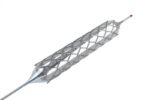Original title: A multicenter randomized comparison of paclitaxel-coated balloon catheter with conventional balloon angioplasty in patients with bare-metal stent restenosis and drug-eluting stent restenosis. Referencia: Seiji Habara et al. Am Heart J 2013;166:527-533.e2. Paclitaxel – eluting balloons have recently emerged as an option for treating in-stent restenosis, both conventional stents ( BMS ) and with drugs (DES ).<a href="https://solaci.org/en/2013/09/25/paclitaxel-eluting-balloon-more-effective-in-restenosis-of-bms-than-des/" title="Read more" >...</a>
In diabetic patients, Everolimus eluting stents could perform better than Paclitaxel eluting stents
Original title: Safety and Efficacy of Everolimus-Eluting Stents Versus Paclitaxel-Eluting Stents in a Diabetic Population Reference: Ana Laynez et, al. Catheterization and Cardiovascular Intervention 81:759-765 (2013) Everolimus eluting stents have already been compared with paclitaxel eluting stents in the general population, and they have proved to perform best, especially as regards revascularization and in-stent thrombosis. However, these data<a href="https://solaci.org/en/2013/04/09/in-diabetic-patients-everolimus-eluting-stents-could-perform-better-than-paclitaxel-eluting-stents/" title="Read more" >...</a>
Paclitaxel eluting balloon in the femoropopliteal region
Original title: Paclitaxel-Coated Versus Uncoated Balloon Angioplasty Reduces Target Lesion Revascularization in Patients With Femoropopliteal Arterial Disease. A Meta-Analysis of Randomized Trials. Reference: Salvatore Cassese et al. Circ Cardiovasc Interv. 2012;5:582-589. Balloon angioplasty is one of the most frequent alternatives used in patients with peripheral vascular disease, especially in the femoropopliteal region. However, its effectiveness is reduced in<a href="https://solaci.org/en/2013/03/27/paclitaxel-eluting-balloon-in-the-femoropopliteal-region/" title="Read more" >...</a>
The use of a paclitaxel eluting balloon in small vessels
Original title: A Randomized Multicenter Study Comparing a Paclitaxel Drug-Eluting Balloon With a Paclitaxel-Eluting Stent in Small Coronary Vessels. The BELLO (Balloon Elution and Late Loss Optimization) Study Reference: Referencia: Azeem Latib et al J Am Coll Cardiol 2012;()doi:10.1016/j.jacc.2012.09.020 The utility of paclitaxel-eluting balloons to treat in-stent restenosis is known but data for novo lesions is more limited. <a href="https://solaci.org/en/2012/11/16/the-use-of-a-paclitaxel-eluting-balloon-in-small-vessels/" title="Read more" >...</a>
Predictors of DCB Failure in De Novo Lesions
Percutaneous coronary intervention (PCI) with drug coated balloons (DCB) is a viable alternative, especially in patients at high risk of bleeding, side-branch lesions in coronary bifurcation, or in small coronary segments. De novo heart disease treated with DCB has been shown non-inferior to conventional DES stenting, according to the PICCOLETO-II trial. However, these interventions are<a href="https://solaci.org/en/2024/07/08/predictors-of-dcb-failure-in-de-novo-lesions-2/" title="Read more" >...</a>
Prehospital Crushed vs. Integral Prasugrel in STEMI Patients with Large Myocardial Area at Risk
Timely percutaneous intervention of STEMI patients effectively reduces MI size and mortality, which currently makes it the first line of treatment. A fundamental aspect is activation and platelet aggregation, which is why, in addition to creating networks to optimize STEMI treatment, prehospital drug treatments have been implemented. The COMPARECrush looked at whether early and powerful<a href="https://solaci.org/en/2024/07/08/prehospital-crushed-vs-integral-prasugrel-in-stemi-patients-with-large-myocardial-area-at-risk/" title="Read more" >...</a>
Cardioband in Tricuspid Valve Regurgitation
Untreated tricuspid regurgitation (TR) has been associated to high morbimortality. Surgical treatment of isolated severe TR is complex and carries a high mortality rate. A transcatheter treatment of this valve is currently being developed, and different concepts are being applied to the new devices. Even though most TR is secondary, atrial functional tricuspid regurgitation (A-FTR)<a href="https://solaci.org/en/2024/07/04/cardioband-in-tricuspid-valve-regurgitation/" title="Read more" >...</a>
Sirolimus-Eluting Balloon in Femoropopliteal Disease
Drug-eluting balloons (DEB) with paclitaxel have shown efficacy and safety in the treatment of femoropopliteal disease. Sirolimus-eluting balloons (DEB S) are currently being introduced. This new drug acts during the cellular resting phase (G0) and is considered potentially more effective than paclitaxel, which is a cytostatic drug. However, there is no conclusive evidence in this<a href="https://solaci.org/en/2024/06/13/sirolimus-eluting-balloon-in-femoropopliteal-disease/" title="Read more" >...</a>
Treatment of Recurrent In-Stent Restenosis with Drug-Eluting Stents: 10-Year Outcomes
In-stent restenosis (ISR) remains the main limitation in the percutaneous treatment of coronary artery disease, with a prevalence between 5% and 10% after implantation of latest-generation drug-eluting stents (DES). Therapeutic recommendations for it include the implantation of a new DES and the use of drug-coated balloons (DCB). The rate of recurrent ISR ranges from 10%<a href="https://solaci.org/en/2024/04/29/treatment-of-recurrent-in-stent-restenosis-with-drug-eluting-stents-10-year-outcomes/" title="Read more" >...</a>
AGENT-IDE: Drug Coated Balloons for Instent Restenosis
Drug eluting stents (DES) have improved considerably over the years, reducing the initial indices of instent restenosis (ISR) by roughly 5-10% a year in USA. However, DES failure might lead to neointimal hyperplasia and neoatherosclerosis, which increases the chance of developing chronic and acute coronary syndromes. Drug coated balloons (DCB), which administer anti-proliferative agents with<a href="https://solaci.org/en/2024/03/21/agent-ide-drug-coated-balloons-for-instent-restenosis/" title="Read more" >...</a>







